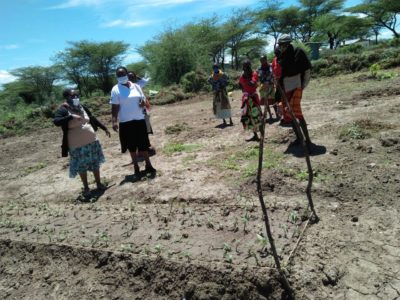With lockdowns, curfews and other constraints along food supply chains, many farmers have struggled to gain access to the high-quality planting materials. Unlike in many other sectors, more than 90% of African depend entirely on rainfall for their crops. This makes adherence to strict planting and harvesting cycles even more important. Small delays can have disastrous impacts on food availability.
So as COVID-related restrictions began to take effect, the International Potato Center teams in Kenya and Uganda reached out to government and other partners to identify alternative ways of reaching farmers with high yielding seed before the ‘window for planting’ had closed. The stakes were high for the families involved. Failure would mean poorer harvests and increased food insecurity.
Before the pandemic, project teams sourced planting materials from vine growers, located throughout the country, who had been trained by CIP and/or one of its partners. Once sourced, the materials were distributed to farmers from a central location close to the farmers. Restrictions on movement, imposed in the aftermath of the pandemic, had made this model unworkable. Transporting bulky and perishable planting materials to farmers would not be possible.
This was common to many businesses throughout the world. What was once a workable business model was no longer fit for purpose. Before the crisis, courier services were actively engaged in delivering packages from businesses to their customers and overnight those businesses went into lockdown. But the authorities had declared activities related to agriculture and food security as essential. So, in March, when restrictions on movement were introduced, employing courier services to deliver essential planting materials to farmers killed two birds. It kept couriers employed, and farm livelihoods and food supply.
“With the lockdowns and curfews currently enforced in Kenya, we had to adapt quickly to link farmers in Isiolo and Samburu counties with high quality planting material,” said Joyce Maru, program coordinator for the UKAID-funded project, Development and delivery of biofortified crops at scale.

Different context, different model, Uganda
In Uganda, CIP and partners teamed up with local teachers and school management committees who coordinated the collection of sweetpotato vines by farmers from vine growers. Over the next few weeks, they organized the distribution of 800,000 vine cutting by 4,000 farm households. Each family will receive 5-6 kg of vines, enabling them to produce about 150 kg of sweetpotato roots, plus 125 kg of vines for the next planting season. That is enough planting material to produce about 1.25 tons of sweetpotato in the next harvest.

“In this way, we used the resource available to make sure that families had what they needed to plant sweetpotato in time for the rainy season,” said Fred Grant, the CIP nutrition specialist in Uganda where CIP is also working with the United Nation’s World Food Programme (WFP), and major international NGOs such as Mercy Corps and Lutheran World Federation, to reach some of the most food insecure families in the country.
Technical support during a crisis
As local extension staff in the target districts in eastern Uganda have already received sweetpotato agronomy training, they continue supporting farm households as part of their government-mandated services.
But the situation is different in Kenya.
The CIP project team had only recently teamed up with WFP and the local governments in the semi-arid counties of Isiolo and Samburu. So they still needed to organize brainstorming sessions with local extension officers and lead farmers to see how they could reach other farmers in the region where travel had been made impossible due to COVID.
“We have shifted our training session online to ensure the knowledge needs of county officers and lead farmers could be met. Using the many resources developed by CIP and partners over the years—such as the Everything you ever wanted to know about sweetpotato manual—learning videos are now a core part of our extension outreach. We are also working on transforming the manual into a series of e-learning modules to support remote learning,” Maru said.
“Despite current requirements on physical distancing, I feel excited that we have been able to support farmers in new ways,” said the WFP policy officer in Kenya, Charles Songok.
Florence Njege, an agriculture extension officer in Isiolo said the videos taught her how to set up nurseries for rapid multiplication of vines. And then she shared this knowledge with her colleagues.
“Because of the training support we received from CIP, we were able to plant sweetpotato more than two week ago and will be able to harvest the crop in three months,” said Njege.

Vitamin A deficiency continues to be a major nutrition challenge in Isiolo and Samburu counties, largely affecting pre-school children, pregnant and lactating mothers, and the rural poor. CIP has partnered with the two county governments and the WFP in a pilot initiative to promote the production and consumption of pro-vitamin A sweetpotato. Promoting sweetpotato production involves an integrated approach that combines behavioral change, investments in nutrition-sensitive value chains and complementary infant feeding interventions.
The Development and delivery of biofortified crops at scale project seeks to expand the benefits of biofortified vitamin A-rich orange-fleshed sweetpotato more broadly, particularly prioritizing vulnerable households and communities most in need. The project is being implemented in Bangladesh, Ethiopia, Kenya, Nigeria and Uganda.
For more information see https://hdl.handle.net/10568/103468
